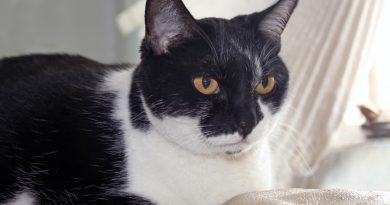Feline Old Age Through to Bereavement – Euthanasia and Getting Another Cat

Very occasionally your vet will ask permission by telephone. This may happen if your cat is having surgery and euthanasia will be kinder than allowing him to regain consciousness, for example the vet discovers advanced inoperable cancers. Your vet is acting in your cat’s best interest. You can refuse permission, just so you can see your cat alive once more, but ask yourself if this is fair on the cat? It will be stitched together and regain consciousness; despite veterinary attention it may be distressed, all for the sake of a few hours.
Sometimes a vet must euthanize seriously ill or badly injured stray cats for which the owner cannot be found. If this happens to your cat, please bear in mind that he has acted to prevent an already dying cat from suffering.
Does My Cat Know What is About to Happen? How is it Done? How Quick is it?
If you are agitated or upset, your cat detects this and becomes upset himself. However, he does not know why you are upset and he does not know that this visit to the vet is any different from other visits e.g. for vaccinations. However upset you are, stay calm and reassure your cat. He reacts to your behavior; he does not understand the word "euthanasia". He may sense that his time has come, but as far as we can tell, cats are not upset at the prospect of their own death.
In pet cats, euthanasia is performed by an anesthetic overdose injected into the vein of a foreleg. Some fur will be clipped from his foreleg first. In some cases, the vein can be difficult to locate and occasionally a couple of attempts may be needed to find it. In elderly or sick cats where the veins have collapsed, the injection may be made into a kidney or the heart. A veterinary assistant, or you yourself, gently restrains your cat while the injection is given. If he is held firmly, but gently, this causes little or no distress. If he is extremely difficult to handle, he may have to be placed in a ‘crush cage’ with sliding sides and sedated first; this is less stressful than trying to corner and restrain an agitated cat.
Most owners want to know how quickly it happens after the needle has been inserted. It happens very quickly. The cat loses consciousness within seconds of the injection starting and death follows a few seconds later. If you are holding him, you will feel him exhale, relax and become heavier in your arms. Urine may trickle from his bladder as the muscles relax. The vet will check for a pulse or eyelid-flick reflex and if there is any chance at all that the cat is deeply unconscious, he will give a second injection into a kidney or the heart. Your cat will not be aware of a second injection if it is needed.
Most vets place the cat into a natural looking sleeping position (he will look as if he has fallen asleep) and close his eyes since animals do not always close their eyes when they die. Because all the muscles of the face have relaxed, his lips may pull back into what looks like a grimace. This is simply due to relaxation of the muscles and to gravity and is not a sign of pain, but can cause concern if you did not expect it.
Should I Stay to the End?
This is a personal decision. Some owners feel that it is their last duty to be there. Others prefer not to be present. Many take a friend or family member with them for emotional support. Most vets allow you to remain with your cat during euthanasia if you wish. If he refuses, ask why and ask for another vet at the practice to perform the euthanasia with you present. If you become distressed, this upsets your cat and make him harder to handle which is traumatic for all concerned. Your vet understands that this is a difficult time and will only ask you to leave if you become so upset that it is impossible for him to perform the euthanasia. If you remain calm this reassures your cat and makes the end very peaceful.
Not all owners wish to be present and there is no shame in this. Some people simply cannot stand the sight of injections. Your vet will allow you to say goodbye to your cat and leave the consulting room. If you are taking your cat’s body away with you, he will call you back in afterwards. Your cat will be treated with as much respect and dignity whether or not you are present.
If you have provided a towel or blanket, your vet will normally wrap or cover your cat’s body. Otherwise, he may place him in a black bag. This is not a sign of disrespect, it is for hygiene and your own privacy. A few veterinary practices have a place where you can sit for a few minutes afterwards and regain your composure. If you do need a few moments before you are able to leave the surgery, tell the veterinary assistant. Alternatively they may be able to help you back to your car, but bear in mind that they are unlikely to have the time to sit with you.
Euthanasia At Home
If you are willing to pay a call out fee, your vet will euthanize your cat in your own home. Both you and your cat may find this less traumatic than waiting at the vets surgery. However, locating your cat when the vet arrives may be a problem as he knows the best hiding places. Many cats have been put to sleep enjoying a last meal of cream or salmon. In the case of a home visit where a veterinary nurse is not available, and the vet does not feel that you are able to restrain the cat, he may sedate the cat first and then inject into the kidney or heart. This is less distressing for all concerned than trying to restrain an agitated cat.
Do not be surprised if your vet makes a hasty exit afterwards, he does not want to intrude upon your grief and he will have other calls to make.
The Price of Euthanasia And When To Pay
The price varies from area to area and vet to vet, but ?15 to ?25 is the normal price range for euthanasia ($30 in the US). It will be more expensive if there are other fees involved e.g. for tests, operations or if the vet performs the euthanasia in your own home.
Vets understand that it is difficult to write cheques when you are in a state of shock or grief. If you are a regular customer he may send you an invoice after a couple of days. Alternatively, you may be able to prepay when you arrive at the surgery – ask about this when you make the appointment and arrive a few minutes early. If you pay in advance or by invoice, you may be able to leave the surgery by its back door rather than walk back through the waiting room.
If Your Cat Dies Unexpectedly or Goes Missing
Many cats die peacefully of natural causes or by euthanasia. Although this is expected or even planned, it can still be a shock when it actually happens. Although the owner of an elderly cat half-expects something to happen, if he dies suddenly or in an accident this is more traumatic for the owner and feelings of grief are compounded by feelings of anger and often guilt.
Following an accident of any kind (outdoors or indoors) it is all too easy to say ‘if only I had done this instead of that’, but you had no way of knowing that he would meet with misfortune. Sudden death is often due to a sudden stroke or heart failure or to an illness or condition where there were no symptoms for you or your vet to detect. A post mortem, should you request it or agree to your vet’s request to perform one, may identify the cause of death. It is unfair to yourself to feel guilty at not noticing signs of illness if there were no signs to for you to detect, but you may wish to discuss the death with veterinary staff. They can often reassure you that death was quick and painless. Try to think of the good times you enjoyed together and, although it is hard, try not to feel guilty about an event you could not have foreseen.
Just as with euthanasia, you need to decide how to deal with his body. If you cannot bury your cat, many vets will allow you to leave his body at the vet surgery where the body can be dealt with by the vet or be collected by a pet cemetery or pet crematorium if you make appropriate arrangements. The following sections may help you decide what to do.
Sadly, a number of cats go missing never to return. This is very upsetting because you do not know what has happened to him and you have no physical body to serve as a focal point for grief and other emotions. There is always that faint hope that he will turn up safe and well one day. As time goes on and it becomes apparent that this won’t happen, you need some way to ‘let go’. You may find it helpful to hold some form of memorial service or wake to commemorate a missing cat. Without a body to bury or cremate, some find it helpful to bury their cat’s favorite toys or blanket to serve in place of a grave, or to have a small memorial plaque made either for his ‘grave’ or for indoors next to a photograph.
Because there is no sense of resolution, the natural grieving process is delayed. It is hard to use common sense to decide how much time passes before a missing cat is ‘presumed dead’. Having a memorial service or burying his ‘personal effects’ may allow you to let go and to feel all the emotions associated with pet death. It is unfair to yourself to hold out hope indefinitely. When a cat goes missing and there is no way of being absolutely certain what has happened, it is natural to grieve for longer and harder to come to terms with the fact that you may never see him again. This is why it is helpful to have something, such as a memorial service, symbolic grave, plaque or photograph, to serve as a focus for your feelings.
Will My Other Cats Mourn? Should I Show Them the Body?
It is impossible to say exactly what emotions cats feel, but if you have any other cats they will certainly be aware that someone is missing from their lives. It is unlikely that they mourn in the human sense of the word, but there will be some behavioral changes as they adjust to the gap in their lives. If they were sociable, the surviving cats may search, cry out or even pine. They need individual attention and reassurance. If they were unsociable or indifferent to each other, the survivors might simply rearrange themselves into a new hierarchy, dividing up their former companion’s territory between them. Sometimes the surviving cat(s) blossom if they were previously bottom of the pecking order.
If there is no danger of infection then this is a personal choice. Some owners say that the surviving cats do not search for a companion, having seen the body. Others say that any veterinary smells on the body disturbed their other cats. They may sniff around the body, lick him and maybe try to wake him up before concluding that their friend has gone. We cannot know what cats understand by death, but they probably have some awareness that a dead animal does not return to life. If there is no danger of infection and you believe that it will help your other cats come to terms with the loss of a companion, then by all means allow them to see and smell the body.
Some owners notice their surviving cats taking on behavior patterns of the missing cat. There is nothing supernatural about this – certain privileges and places once accorded to the missing cat are now up for grabs. This means the prime spot on the bed or being allowed to eat in a certain place. In all likelihood, the deceased cat defended these rights during its lifetime (maybe simply by staring down its companions) and the survivors see these behaviors as being part of the hierarchy.
How Do I Dispose of the Body?
There are several options for disposal of your cat’s mortal remains following death. In the case of a terminal illness or old age when euthanasia is not sudden or where death is expected, owners are encouraged to think about the disposal of the body in advance. These depend on where you live and on how much you wish to spend.
Only in cases where the body poses a serious risk to human health (e.g. rabies, should it ever enter UK) will you be denied permission to deal with his remains as you wish. Unless your cat died of a contagious disease such as rabies, you are free to bury him, cremate him or leave him with the vet for incineration. Or, you may wish to "keep" him through taxidermy, freeze-drying, resin preservation (plasticisation) or cloning (at present tissue is banked for future cloning). The decision depends on where you live, local laws and how much you wish to spend.
Your vet can dispose of the body for you. The body will be stored in a veterinary deep freeze (for hygiene purposes) and collected for incineration by a firm licensed to incinerate animal remains or ‘medical waste’. Some vets can provide individual cremation; it is best to ask about this in advance if possible so that you know what options are available to you.
You can arrange for a pet cemetery or pet crematorium to collect the body from your vet. The body will be labeled with your name and the cat’s name, and stored in the veterinary deep freeze until collected. If the euthanasia was expected, you may be able to take the body to the pet cemetery or crematorium yourself. Burial, cremation or incineration are the normal means of disposing of your cat’s mortal remains. Some owners arrange to donate their cat’s remains to a nearby veterinary school in the same way that people donate their bodies to medical science.
Burial
Burial is the commonest option in Britain where many people have a garden or an understanding friend with a garden (I have my apartment-dwelling friend’s cats buried in my garden). Make sure local bylaws don’t prohibit this. If you bury him in the garden (yard), the grave should be at least three feet (1m) deep to discourage scavengers. Wrap him in a shroud of cloth and lay him at the bottom of the hole. Fill up the hole with soil, bearing in mind that it will settle over the next few weeks. It is a sensible precaution to lay a paving slab on top to deter scavengers from digging up the body. Once it has been buried, you are not permitted to exhume an animal’s body.
Bury the cat as soon as possible after death; it will begin to putrefy quickly. If this is not possible, ask the vet to store the cat in the clinic’s freezer. If you do not collect your cat’s body by the due date, it will be sent for mass cremation. If you bury your cat in your garden, you may wish to erect a headstone, plant flowers or a bush to mark the grave.
If you do not have a back garden or local bylaws prohibit pet burial, look for a pet cemetery (listed in the Yellow Pages, pet magazines or most vets have contact information). Most have a chapel of rest and facilities for a non-denomination ceremony (usually Christian, but you should state if you prefer a non-religious ceremony). Ceremonies and ceremonial interment must be scheduled in advance. Some pet cemeteries will collect your cat’s body from the vet or from your own home.
If you take your cat home for burial, he must be buried as soon as possible (within hours) otherwise putrefaction (decay) will set in. If you cannot take your cat’s body home immediately, your vet may be able to store it in the veterinary deep freeze for a day or two. It is not advisable to store the body in your domestic deep freeze. If you do not collect the body on the arranged day, it will be collected for incineration.
Cremation
The second most popular option in Britain (and increasing in popularity) and possibly the most popular option in the US is cremation. Many people today choose cremation. Then you have the choice of scattering kitty’s ashes in its favorite places or bringing them home in a jar. Pet crematoria are usually combined with pet cemeteries and listed in the Yellow Pages, pet magazines or your vet may have contact details. They may also have a memorial garden or columbaria (wall of niches) for pet ashes.
Pet cemeteries and crematoria offer several services: individual cremation where the ashes are either returned to you or buried at the crematorium; cremation with other animals with the ashes scattered in the garden of rest or individual burial in a cemetery plot. Pet cemeteries have no legal protection so check that it is not likely to be bought up for redevelopment.
Taxidermy
Some cat owners have their cat "stuffed" although the results may be disappointing. Only the skin, fur and claws will be real. The eyes will be glass and the facial expression will be frozen and may appear distorted. Ask to see samples of the taxidermist’s work first. However good the taxidermist is, the cat’s expression rarely looks "quite right" and for this reason, many will not taxidermize domestic pets. Everything which made your cat what he was (muscle, bones, brain) will have been disposed of as medical waste.
The actual process used (the stripping out of internal tissues and bones, the "tumble-drying" of the skin) lacks dignity and appears unsympathetic, but remember that your cat’s spirit (soul, essence, being) is no longer inside. You may be able to arrange for cremation of the flesh and bone part of you companion.
Freeze-Drying
Freeze drying or desiccation takes approximately 6 months and slowly desiccates (removes water from) the cat’s body. The cat will be put into the desired pose before freeze drying starts and some cosmetics are needed to pink-up the ear flaps, nose and other areas not covered by fur. This process is similar to natural mummification. The process is relatively new and the long term results not known. The freeze dried cat may have to be sealed into a glass container as moisture and temperature fluctuations will cause slowly deterioration of freeze-dried tissue (as they have to exhumed mummies).
Cloning
Cloning hit the headlines recently when Dolly was cloned from an adult sheep. The possibilities excited cat owners who desired to duplicate a departed pet. In cloning, the nucleus of a tissue cell is implanted into an unfertilized egg and this is grown inside a surrogate mother cat. The kitten will be genetically identical to the donor cat. Cloning reproduces the genes, not any traits developed due to environment. The clone will look like the original cat but may have a different personality and grow into a totally different individual. You may begin to resent the clone for not being the cat you remember.
Cloning currently has a very high failure rate. One problem is that cells have an internal clock which tells them how old they are. Your clone kitten may have been born 6 weeks ago, but all its cells know they are 15 years old. This causes premature ageing and deterioration and probably an early death. Some people are banking tissue samples from their cats waiting for the day when cloning is perfected and affordable; this may not be within their own lifetimes.
Resin Preservation
It is possible to preserve bodies by replacing the blood and body fluids with resin which sets solid. This is a form of embalming which can produce an extremely lifelike effect while leaving all internal tissues in place. Plasticisation has been used with humans (in Germany, I believe) as a form of art, but may become available for pets if there is a demand for it. It is still rare, but for owners has the advantage that the internal tissues remain intact and are not discarded as they are with taxidermy.
Donation of Body to an Institution
You will have to discuss this option with your vet while your cat is still alive; he may be able to refer you to a small animal hospital where vets are trained. Sometimes museums or other institutions advertise, asking for exhibits e.g. of certain breeds or of oddities such as cats with extra toes. If you know that your cat does not have a long life-expectancy and do not mind its fur, teeth and claws being used in this way you may wish to contact the institution.
Since taxidermy has no use for other body parts, you could ask the museum to arrange individual cremation of the remaining parts (the museum may agree to pay for this in return for your permission for taxidermy) or for their transfer to a veterinary teaching hospital (donation to veterinary science, above).
Replacement
Instead of preservation of the body or cloning, you may wish to adopt a cat which is the same color or breed as your original cat. It will be an individual and it depends on how you feel about being reminded about your old cat. Some people prefer to have a cat which looks totally different to avoid the constant reminders. Some people do not mind at all what color the cat is because companionship (or rescuing an unwanted cat) is more important to them.
Others always adopt a cat of the same breed because it will have a similar temperament and may even be related to the previous cat. There are plenty of people who have owned a black and white cat called Tiddles throughout their life figuring that they’ll never forget its name even if each Tiddles is a little different to the previous Tiddles.
It is up to you as to when to adopt another cat. You may need time to grieve or you may want another feline companion at once. You may have other pets or family members who urgently need feline company. Some people put the needs of cats before their own needs and adopt a shelter kitty the very same day to ensure it has a loving home and will not be put to sleep. The timescale for getting another cat will also depend on whether any viruses or infectious agents are left in you home from your previous cat – you may be advised to wait a month for these to die. If your cat was put to sleep as the result of an infectious illness, then your vet may advise you to let a period of time elapse before getting another cat. This is to reduce the risk of infection remaining in your home.
Apart from this, it is a personal decision. Some people cannot live without feline companionship and get another cat almost immediately, sometimes within hours. Others would consider this to be indecent haste. Many owners need a period of time to come to terms with the loss of a pet; how long this takes varies from person to person. Some feel that getting another cat too quickly would be disrespectful to their former companion. A few owners take on another cat before their pet goes into terminal decline; this is only possible if the cat is sociable and there is no risk of infection. Remember that the new cat will not replace the one you have lost. He will commemorate your previous cat, but will have a personality all his own. If you try to replace your cat with an exact duplicate, you are likely to be disappointed as all cats are individuals.
Coping With Pet Bereavement
Cats have a shorter life-span than humans although we would like to think our cats are immortal, especially if a cat is relatively healthy in his late teens or early twenties. The death of a well-loved pet is on a par with the death of a child or teenage human family member, despite what thoughtless people may say. It is doubly hard if you cat was rescued by you, nursed through illness, belonged to an deceased family member or was your main companion. Grief or anger are natural reactions to the death of an animal companion. We react differently to death, but we all need time to come to terms with the loss of a close animal companion. You might seek consolation in remembering the joy that your cat brought you.
No-one who has had to make the decision to euthanize their pet cat will deny that there are feelings of loss and perhaps guilt. However you may find some comfort in having been able to be merciful to your loved one. You have taken on the pain of a loving act of mercy in exchange for sparing your cat further suffering.
It often helps to share your feelings. There are four stages of grieving: denial, anger, depression (mourning) and acceptance. Suppressed feelings are likely to resurface twice as painfully later in life or when you feel vulnerable for other reasons. I found that people who had never lost a pet could be unconsciously or deliberately unsympathetic. With so many people relying on a pet for companionship, this is unfair of them and may even indicate problems in their own relationships. However, many GPs and religious ministers are sympathetic to those who suffered pet bereavement and can offer counseling. Time is said to be a great healer, and though the pain may never go completely, time numbs the pain and makes it more manageable.
There are Internet newsgroups and bulletin boards where you can share your feelings with other bereaved pet owners. Use a search engine to look for "pet loss" and "pet bereavement" and you will find hundreds of sites offering a variety of resources, including email or online counseling. There are ‘virtual cemeteries’ where you can post up a photo and message of remembrance for your pet and virtual ‘candle ceremonies’. It sounds macabre to some, but many pet-owners hold an online ‘funeral’ or service (religious or non-religious) for their cat, attended by cyberspace friends and these can provide reassurance as people exchange feelings and anecdotes about their pets life. You may wish to place an obituary in a cat or pet magazine.
I adopt older or ill cats. Over the years, I have seen many of them die. I have also seen how other people react to me. Some are embarrassed because they have no experience of pet loss. One manager granted me compassionate (paid) leave so that I could arrange burial. Another (with experience of elderly cats) granted unpaid leave for the day of euthanasia and the burial the following day. When I likened the loss of my 11 year old cat to the death of a child I was verbally abused by many people in my office who said that the comparison was not valid because a cat can be replaced, but a child can’t be replaced.
These were people who placed very little value on the life of a pet and their attitudes were hurtful (and some were deliberately spiteful). They have no comprehension of the effect of pet-loss on caring pet-owners, especially on pet owners who are single, childless or widowed (where the pet was a final bond with a deceased partner). I decided to choose better friends who would support me in my grief even if they did not agree with how I felt.
What Do I Tell the Children?
Children and cats often have very special bonds. The cat is a playmate, companion and will never, ever pass on any secrets told to it. He attends dolls’ tea-parties and get pushed around in a pram as well as many other indignities. He is there when a child is sick, he scares away the monsters when a child is scared of the dark. He eats things sneaked from off the plate. Often he is simply there giving unconditional, non-judgmental love. So, when he cat dies, the child may take it very hard.
Don’t tell a white lie in the hope of making things easier; it can cause a lot more distress than the truth. One of my friends was told that her adored cat had been sent to a farm to live happily with other cats. Later the parents changed this to "he ran away". She waited at the garden gate every evening for over a year until her parents told her the truth. All that she gained from the experience was a feeling that parents were not to be trusted and a feeling that she never had a chance to properly grieve for her cat’s death.
Death is hard for a child to understand, so help him to understand that death is natural and happens to very old and very sick animals and people. A child’s experiences are all learning experience; knowing about death can help him to cope later on when elderly family members die. If your child is young, don’t use the euphemism "put to sleep" as the child may expect the animal to wake up and return or try to exhume the body; some children develop a fear of going to sleep in case you bury them.
The may be upset at the thought of their cat waking up in the dirt. Explain that the cat was very old or very sick and that the vet couldn’t mend it (children often think in terms of mending things). Explain that vets do make sick cats better but that sometimes cats are just too sick and that the vet helped it to die without being in pain; otherwise the child may think that vets kill animals and may become distressed when another animal goes to the vet for routine treatment.
If you have to leave your cat at the vet clinic for disposal, let your child say goodbye before the body is deep frozen (avoid mentioning freezing in case junior attempts to freeze your other pets). Involve your child in a remembrance service at home to provide a focus for their grief; it isn’t simply a case of "out of sight, out of mind". Make sure he has a photographs to remember the cat by.
Ask your child to help with any funeral or burial service; for example choosing a blanket or a tee-shirt (may be an old one belonging to the child) to wrap the cat in or a cat toy to be buried or cremated with it. Children don’t understand that their cat can’t feel anything and may worry that he will be cold under the ground; you might say that he will be warm wrapped in a towel. If you choose a burial service or cremation, your child can help to choose a coffin (casket) or an urn. I have known older children put great store by the fact that they helped mum or dad make the coffin – anything from decorating a cardboard box, to helping with real woodwork.
If you have a service, ask the minister for one that celebrates life rather than being at all morbid. If you choose hymns or songs, your child can choose a favorite even if it adults may think their choice is not the most suitable for a dignified occasion – you probably already have ways of coping with death, you are trying to reassure your child. If your child is involved in after-death arrangements, it may help in their understanding that death is natural and permanent.
If you are religious you may say that God cares for animals too and that your child will meet his pet in heaven one day (this can neither be proved no disproved and is therefore, not technically a lie). Many religions believe in reincarnation or that animals have souls, albeit simpler ones than humans and since animals cannot commit sins, they are assured of a heavenly place. Some spiritualists consider that animals have a species communal soul and that pets develop individual souls because they come to understand that they are distinct individuals.
If you are not religious you may say that older animals die to make room for baby animals and so that everything can grow and renew itself. As a young child, all my goldfish were buried beneath certain trees because they "helped" the tree to grow strong and tall. I came to feel that my pets lived on as part of the trees.
As an adult, I can look out on an especially vivid patch of my lawn which is exactly the same size and shape (a sort of comma shape) as the elderly cat I buried last year. For one year at least I have a visible living memorial of my cat and her contribution to the continuity of life.
Remembering Your Cat
Whether you are alone or have a family to join you in thinking about your cat, focus on the good times you had together and remember the happiness and pleasure you gave to each other. Talk about funny events in your cat’s life, not about the last few days or weeks when your cat was going downhill. Think about how you would like to be remembered – for the good times in your life. There are several ways of commemorating your cat.
You might choose a memorial plaque or stone planter placed in your garden even if you did not bury your cat there; maybe it can mark a favorite spot where your cat liked to sit. If you don’t have a garden you could have a small engraved plaque or a special urn for your cat’s ashes indoors. Some people turn this into a small "shrine" with a photo or painting and one of your cat’s favorite small toys on a shelf; and they light a small candle or incense stick on important dates.
You might hold a commemoration service with sympathetic family members and/or friends; if you are a single person this could be with any remaining pets – they are not judgmental and expressing your feelings aloud may help you.
Some people plant a tree (or adopt a tree) or name a star after their pet and receive a certificate in recognition. You might sponsor an unhomeable shelter kitty or sponsor a shelter pen – you will help many other cats as well as commemorating your own; the shelter may allow you to place a small metal plaque on the pen or on a memorial wall.
Some people express gratitude for the years of pleasure their cat has given them by volunteering a few hours a week or during a holiday to help out at an animal shelter or other voluntary organization involving animal welfare.
If you enjoy writing, write a poem or short article about your cat and pin it up at home or share it with others by posting it to a web-site, newsgroup or bulletin board. You might keep a journal of your feelings and memories to create a written tribute. It could be a scrapbook or illustrated biography of your cat or your life with your cat; this could be a private book or some pages on the web to help and reassure others. If you are artistic, you could paint a portrait or make a model, tapestry, rug or other item bearing your cats image.
How Soon Should You Adopt Another Cat and Where From?
The timescale for adopting another cat depends entirely on you. You may wish to pass through the stages of grieving first or you may wish to get another feline companion as soon as possible. Most people need to let several weeks elapse. Some people never get another cat, feeling that they are being somehow unfaithful to the memory of their previous cat. Sadly they are denying themselves the pleasure of continued feline companionship.
This may be due to unresolved grief issues which require counseling. People who work with animals frequently get another cat much sooner (sometimes within in hours), because they have "a vacancy" for a cat which may face destruction. They feel the same amount of grief, but for them the best way to remember their cat (possibly also a rescued cat) is to save another life.
Sometimes the decision to get another cat is made because the children, or possibly other pets, require a cat companion. Some dogs and certain sociable breeds of cat react this way; they may not even be best of friends, but they rub along together and just need each other’s company. I have encountered 5 very grief-stricken Golden Retrievers who were only perked up by the addition of a new cat to rule the roost.
Pets enrich life and provide you with non-judgmental companionship. I know a woman with terminal MS who would have given up and died years ago if it wasn’t for her cats giving her a reason to get up each morning. Unlike dogs, cats do not require a great deal of space or daily walks, making them better suited to smaller homes, less active people or those who work full-time. People who share their homes with pets suffer less stress, may retain their physical and mental faculties for longer and live longer.
Stroking a pet aids relaxation and lowers blood pressure. Cats provide the opportunity to care for and nurture another living thing, one which gives unconditional and undemanding love. Cats have an independent streak, but they are also good listeners and despite the views of non-cat lovers, many cats are highly sociable with selected people and are as demonstrably affectionate and devoted as dogs. They also provide a topic of conversation helping you to meet and chat with likeminded individuals, either in the flesh or on the web.
You can never replace the cat you lost but you can adopt or purchase another to share your life. This will be a new cat with his own personality and behavior, not a replacement cat. Though he may physically your previous cat, especially if he the same breed, his personality is its own. Some people prefer to have a cat which looks totally different to avoid the constant reminders.
Some people do not mind at all what color the cat is because companionship (or rescuing an unwanted cat) is more important to them. Others always adopt a cat of the same breed because it will have a similar temperament and may even be related to the previous cat. As I wrote earlier, there are plenty of people who have always owned a black and white cat and always named it Tiddles, figuring that they’ll never forget its name even if each Tiddles is a little different its predecessor.
If the previous cat was poisoned, stolen, killed by another animal or a person, or run over, you may decide against adopting another cat unless you can keep it indoors all the time or have a safely fenced garden. If you are an older person, you may decide that a kitten is too lively and may outlive you. Adopting an older cat makes sense as you can share the quiet times.
If you have other pets in the house, they may or may not accept an intruder. Most will get used to each other if they have been used to other feline companions and will eventually establish a pecking order and divide up or timeshare territory even if they do not become good friends. Make sure that all have been vaccinated and do not pose a health risk to each other.
A Kitten or an Adult Cat?
This depends on yourself and on any remaining pets. If you have other older cats they may resent the intrusion of a lively kitten – or they may get a new lease of life as mentor to the kitten. If you adopt another older cat you will have some idea of its personality (from the previous owner or the shelter) and can adopt a laid back, non-competitive cat which will not threaten your surviving cats. I find that where all the cats are older, lack of energy and desire for warm sleeping spots usually overcomes aggressiveness!
Where Should I Get Another Cat?
Where you should your get a new cat from depends on whether you want a pedigree or non-pedigree pet and on the animal shelters in your area. Some owners specialize in taking on older or disadvantaged cats from animal shelters and making their remaining years happy and comfortable. Such cats may repay your kindness a thousand-fold. You may know of a friend unable to keep his or her own cat due to changed or diminished circumstances.
If you want a pedigree cat, check breeder advertisements in cat magazines or visit cat shows. In the UK, cats are not bought or sold at cat shows, but breeders take enquiries and may take bookings. Sometimes there are variants (cats which don’t quite match the standard) available at lesser cost. Pedigree rescue societies specialize in rehoming purebred and pedigree cats which have lost their homes; these cats are usually older and may have no papers, but are nevertheless loving purebred cats. Beware of kitten-farmed "purebreds" (see below) many of which are not pedigreed at all. Some cat shelters also have purebreds and you might find pedigree look-alikes at cat shelters, due to accidental crossbreedings in a cat’s family tree!
If you are looking for a moggy or non-pedigree cat, contact your local animal shelter and check your vet clinic notice board for "looking for home" cards. Many stray and abandoned cats end up at vet clinics before reaching an animal shelter. Vets may have clients whose cats have had kittens or who are looking for new homes for their own cats due to changed circumstances. Some vets in some countries take in and rehome unwanted cats and dogs (strays or healthy animals taken for euthanasia). If you know your pet shop to be reputable, there may be a rehoming notice board there.
Sources of Cats – The Good, the Bad and the Ugly
Beware of newspaper/notice board adverts, people selling kittens from a box in a shopping center, many pet shops and markets/boot fairs. Though there are many reputable pet shops, there are too many which sell kitten farm kittens or unhealthy stock. Only acquire cats and kittens from a pet shop where you have already built up a good relationship and know them to be reputable and caring. The very best pet shops refuse to deal in live animals and will refer you to a breeder, animal shelter or vet.
Side-of-the-road vendors and kitten-farms (US: kitty-mills) are concerned with quick sales and profits, not with the health of the "product". The kitten may have a hereditary condition, be malnourished, wormy, sick and poorly socialized; some will never have been handled and are virtually wild – their docility when sold being due to fear or illness.
They will have lived in overcrowded conditions, mixed with other litters from elsewhere in the county or country and be harboring any number of infectious diseases. The mother may be sick or dying through excessive breeding and the kittens are probably removed at too young an age; by purchasing such a kitten you keep kitten farms in business. If they are purebreds, they may come with false pedigree papers and be unregisterable; not be a concern if you don’t plan to show or breed, but they will still have been bred in poor conditions. Their parents were probably acquired with a neutering contract and the kitten farm will have lied to the breeder saying that the cat has been neutered or has died. Better sources for purebreds are reputable breeders, breed rescue societies, animal shelters and vet clinics.













